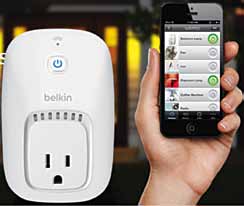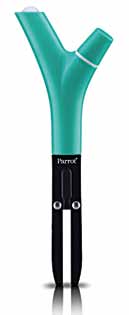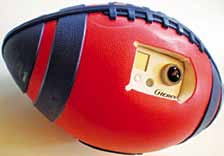
Inside: WeMo Switch looks like any normal power switch (although it is definitely bigger), and can also be controlled physically like ormal switches. It is Wi-Fi capable—and can be remotely controlled through an app that runs on iOS 4.3 or higher version. Belkin is apparently also addressing customer requests for an Android version of the app. Apart from simple remote on/off controls, WeMo can also be scheduled to switch on or off at specific imes. It can be programmed to react to situations using a service called IFTTT, which is actually the most innovative aspect of WeMo. IFTTT stands for ‘if-this-then-that.’ You can set up WeMo equipment to react to changes. For example, you can set it up to switch on when somebody comes in. Better still, it is Web-enabled, so you can link the functioning of devices to, say, weather reports, or you can turn it on or off using Twitter or other social media messages. WeMo can also talk back—it can post information or trigger events on Facebook, Twitter, etc, send you an SMS or update Google Calendar!
Wireless sensor to take good care of your plants
Many of us love gardening but are not smart enough to take good care of plants. Well, caring for plants is tough—you need to understand when they need water, shade or even nutrients. Imagine having an electronic advisor that knows all this, monitors your plants personally and advises you on what to do, through a mobile application. Well, that is precisely what the Parrot Flower Power solution does, using sensors and a mobile app. It is a small device from the makers of the Parrot AR Drone, which plugs into the soil in your garden and helps take care of plants in the vicinity. Flower Power will be launched this year.

Inside: The Parrot Flower Power device includes sensors that measure sunlight, soil moisture, temperature and fertiliser content in soil. It is Bluetooth Smart capable, and keeps sending information to a dedicated iOS application, which monitors and analyses the sensor data. The app includes a comprehensive database with information about 6000+ species of plants. Once you plug your Parrot Flower Power device into the soil, you need to choose the type of plants in the garden. If you do not know this, you can search the database based on leaf type, colour and a number of other options. Apparently, you can associate the device with any number of species. Once this simple setup is over, you are ready to go. The device keeps sending information to your app every 15 minutes. The app then puts two-and-two together and decides whether the plants have sufficientlight, water and fertiliser to grow well. It then pushes notificationsto your phone about the status of the plants and action to be taken. The information may also be plotted in the form of a graph or analysed in other ways for long-term benefts.
Record a game from the ball’s view
When training for football games, coaches like to watch the game from several points-of-view in order to train their players better, develop strategies and improve the moves. Cameras and image processing software are very helpful in this task—providing close views from multiple angles, trajectory analysis and more. However, what has been missing till date is the view from the ball!
BallCam is a new technology developed by researchers at the Carnegie Mellon University and the University of Electro-Communications (UEC) in Tokyo, which allows a video camera to be embedded in a ball, thereby capturing smooth video as it spins through the air. While this might be illegal in officil games, such recordings will surely be useful for training purposes. What is more, it might even vividly record the expression on a player’s face when he misses a ball!

Inside: BallCam features a high-definition, wireless GoPro HERO 2 camcoder inserted into a hole on the side of a rubber-sheathed plastic foam football. (In the future, GoPro can be used with the company’s yet-to-be-launched Wi-Fi control pack that will let the camera be controlled through smartphones.) One of the biggest problems in recording video from a spinning object as fast as a football is the resulting blur. BallCam uses a special algorithm to process the video from balls spinning at up to 600 rpm. The algorithm is designed to monitor and discard video frames that show only the sky. When the remaining frames are stitched together, the result is a relatively smooth, wide-angle view from the side of the football. The stitching software is similar to what NASA uses to stitch together images from its Mars rovers. So the technology is quite complex—and certainly not ‘playful’ stuff! The researchers say that the prototype can be enhanced to include multiple cameras and better camera sensors too.





